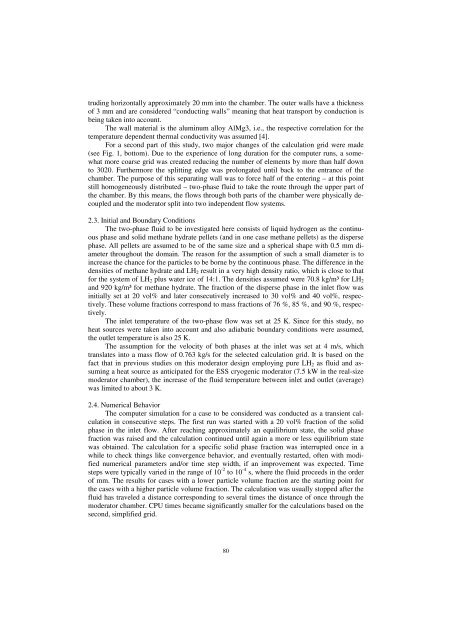Druck-Materie 20b.qxd - JUWEL - Forschungszentrum Jülich
Druck-Materie 20b.qxd - JUWEL - Forschungszentrum Jülich
Druck-Materie 20b.qxd - JUWEL - Forschungszentrum Jülich
Create successful ePaper yourself
Turn your PDF publications into a flip-book with our unique Google optimized e-Paper software.
truding horizontally approximately 20 mm into the chamber. The outer walls have a thickness<br />
of 3 mm and are considered “conducting walls” meaning that heat transport by conduction is<br />
being taken into account.<br />
The wall material is the aluminum alloy AlMg3, i.e., the respective correlation for the<br />
temperature dependent thermal conductivity was assumed [4].<br />
For a second part of this study, two major changes of the calculation grid were made<br />
(see Fig. 1, bottom). Due to the experience of long duration for the computer runs, a somewhat<br />
more coarse grid was created reducing the number of elements by more than half down<br />
to 3020. Furthermore the splitting edge was prolongated until back to the entrance of the<br />
chamber. The purpose of this separating wall was to force half of the entering – at this point<br />
still homogeneously distributed – two-phase fluid to take the route through the upper part of<br />
the chamber. By this means, the flows through both parts of the chamber were physically decoupled<br />
and the moderator split into two independent flow systems.<br />
2.3. Initial and Boundary Conditions<br />
The two-phase fluid to be investigated here consists of liquid hydrogen as the continuous<br />
phase and solid methane hydrate pellets (and in one case methane pellets) as the disperse<br />
phase. All pellets are assumed to be of the same size and a spherical shape with 0.5 mm diameter<br />
throughout the domain. The reason for the assumption of such a small diameter is to<br />
increase the chance for the particles to be borne by the continuous phase. The difference in the<br />
densities of methane hydrate and LH2 result in a very high density ratio, which is close to that<br />
for the system of LH2 plus water ice of 14:1. The densities assumed were 70.8 kg/m³ for LH2<br />
and 920 kg/m³ for methane hydrate. The fraction of the disperse phase in the inlet flow was<br />
initially set at 20 vol% and later consecutively increased to 30 vol% and 40 vol%, respectively.<br />
These volume fractions correspond to mass fractions of 76 %, 85 %, and 90 %, respectively.<br />
The inlet temperature of the two-phase flow was set at 25 K. Since for this study, no<br />
heat sources were taken into account and also adiabatic boundary conditions were assumed,<br />
the outlet temperature is also 25 K.<br />
The assumption for the velocity of both phases at the inlet was set at 4 m/s, which<br />
translates into a mass flow of 0.763 kg/s for the selected calculation grid. It is based on the<br />
fact that in previous studies on this moderator design employing pure LH2 as fluid and assuming<br />
a heat source as anticipated for the ESS cryogenic moderator (7.5 kW in the real-size<br />
moderator chamber), the increase of the fluid temperature between inlet and outlet (average)<br />
was limited to about 3 K.<br />
2.4. Numerical Behavior<br />
The computer simulation for a case to be considered was conducted as a transient calculation<br />
in consecutive steps. The first run was started with a 20 vol% fraction of the solid<br />
phase in the inlet flow. After reaching approximately an equilibrium state, the solid phase<br />
fraction was raised and the calculation continued until again a more or less equilibrium state<br />
was obtained. The calculation for a specific solid phase fraction was interrupted once in a<br />
while to check things like convergence behavior, and eventually restarted, often with modified<br />
numerical parameters and/or time step width, if an improvement was expected. Time<br />
steps were typically varied in the range of 10 -2 to 10 -4 s, where the fluid proceeds in the order<br />
of mm. The results for cases with a lower particle volume fraction are the starting point for<br />
the cases with a higher particle volume fraction. The calculation was usually stopped after the<br />
fluid has traveled a distance corresponding to several times the distance of once through the<br />
moderator chamber. CPU times became significantly smaller for the calculations based on the<br />
second, simplified grid.<br />
80

















